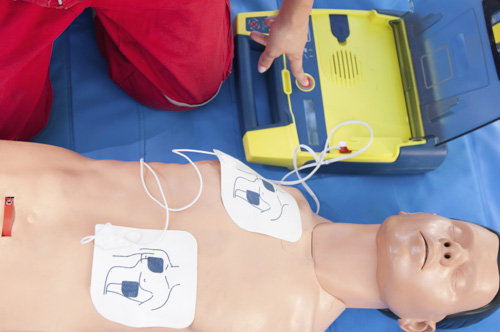CPR #2
Samples of Course Materials

Sample #1
Case 1
You are working in a warehouse when you hear cries for help in the next room. Since you know First Aid and CPR, you walk into the room to see if you can help. You find several co-workers standing near your friend, an electrician, lying on the floor. You notice a pair of wire cutters lying near your friend's hand and several arching wires near his head. He does not respond to you calling his name. How would you respond?
The answer is in the CPR Case Studies Answers section of this course.
Case 2
You are at a local swimming pool when lifeguards pull an unconscious middle-aged male from the water. You inform the lifeguards that you know CPR and can help. They begin the steps of CPR and direct you to call 911 and get the AED. After calling 911, you return with the AED. The lifeguards ask you to apply the AED, but you notice the patient is still wet from the pool. Another bystander yells out that you can't use an AED on a wet victim. What should you do?
The answer is in the CPR Case Studies Answers section of this course.
Case 3
You are enjoying dinner with your family at a local restaurant when the woman next to you abruptly ….
More in course materials...
Sample #2
Compressions
Once you have identified that an adult is in SCA and requires CPR (and the emergency response system has been activated), the next step is chest compressions. In review, identification of SCA involved two major steps:
- 1. Check for Responsiveness
Attempt to wake the patient: Shake or tap the patient and shout, “Are you ok?” - 2. Check for Signs of Life
Look for chest rise (indicating breathing), listen for grunting, groaning, or sounds of heavy breathing, or place your hand on the patient’s chest to feel for rise and fall.
Advanced provider: check for pulse, airway, and breathing issues.
Chest compressions squeeze the heart, building up pressure within the heart’s chambers to begin pumping blood. Good compressions circulate oxygenated blood throughout the body, slowing the damage to the heart and other organs caused when these organs have stopped receiving blood from the heart. It is important to provide good, quality chest compressions during CPR to maximize blood flow and increase the chances of survival. Let’s look how to perform chest compressions...
More in course materials...
Sample #3
Allergic Reactions
An allergic reaction is the body's response to an allergen and is usually not an emergency. Minor reactions consist of red, itchy skin often at the site of the allergen such as a bee sting. Other common, non-life-threatening responses include hives and minor swelling. In these cases, no emergency care is needed. If the cause of the reaction is an insect bite or sting, remove the stinger by scrapping a credit card or other small, hard object across the skin, and apply a cool wet compress to reduce discomfort. DO NOT use tweezers when removing a stinger as it will cause more toxin to be injected into the skin potentially …
More in course materials…
Sample #4
Seizures
A seizure is caused by abnormal activity in brain cells. This can cause a victim to suddenly begin experiencing severe muscle convulsions in an area of the body or even the entire body. In many cases the victim loses consciousness during the convulsions which can often continue for several minutes after the convulsions have stopped. Seizures can be caused by conditions such as epilepsy, a dramatic drop in blood sugar, and even simply due to a high fever especially in children under five.
When assisting a victim experiencing a seizure, if he or she is not already lying on the floor, assist them to the floor and call 911. Clear the area around the victim so that the convulsions don't cause further injury. Do not attempt to stop the convulsions…
More in course materials...

